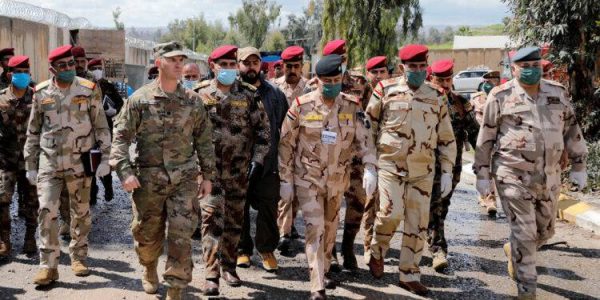
Islamic State attacks surge in Iraq amid the debate on U.S. troop levels
The assailants came at dusk, creeping on foot through the dusty palm groves near the Tigris River, armed only with a rocket-propelled grenade, a light machine gun and Kalashnikovs. They had laid roadside bombs to kill anyone who rushed to help the unsuspecting local guards, who were in their sights.
When the attack on the village last month was over, nine members of a Sunni tribe that had opposed the Islamic State were dead and four were wounded, one of them nearly burned to death.
This is the Islamic State in Iraq in 2020: low-tech, low-cost, rural, but still lethal. And while it has not carried out attacks on the scale that it did a few years ago, the number of attacks has begun to grow again.
As American and Iraqi negotiators begin a new round of strategic talks on Thursday, the question of how to respond to the Islamic State’s quiet resurgence — and how much American help is required to do so — will be at the center of the discussion.
There are currently about 5,200 American troops in Iraq, whose main missions are counterterrorism and training Iraqi forces.
The Trump administration, which sees the American presence as crucial for tamping down the resurgence of ISIS and as a bulwark against Iranian power in Iraq, wants to keep a substantial force there.
“We’re going to continue to maintain forces as long as the Iraqi government is willing to have U.S. and coalition forces present in the country until the enduring defeat of Daesh is accomplished, and it’s not yet accomplished,” James F. Jeffrey, the American special envoy to the region, said in a briefing on Friday, using the Arabic acronym for ISIS. “That’s our policy.”
But there has been pressure on both sides to reduce the American military presence.
Congress has increasingly questioned the continued American troop presence in Iraq.
The Pentagon is reluctant to keep more than the absolute minimum of troops there because they have been attacked by Iranian-backed militias. An attack on an Iraqi base in March killed three soldiers of the American-led military coalition in Iraq, two of them Americans, and wounded 14.
Since then, the military has consolidated its troops on fewer bases. Separately, the training mission has been suspended for the last few months because of concerns about the coronavirus.
Pentagon officials believe they can do the job with roughly half the current American force and have plans to reduce the number of troops in Iraq to 2,500 to 3,000, but have no fixed numbers or timetable. Other members of the 29-country American-led military coalition have already cut their numbers in half, to about 1,200 troops, because of the coronavirus pandemic.
On the Iraqi side, the country’s Parliament, furious over the American airstrikes in Iraq that killed an Iranian military leader and several Iraqi officials, passed a resolution in January demanding the withdrawal of American forces.
On Monday, the influential nationalist Shiite cleric, Moktada al-Sadr, called on the United States to withdraw and end its “aggressive and highhanded behavior toward the world.”
The Iraqi government has not acted on the parliamentary resolution, which was nonbinding, and the Iraqi military is reluctant to have the American troops leave altogether. While the Iraqis say they can do the fighting on the ground themselves, they say they still need help in reconnaissance, air support and training.
The talks starting Thursday, which last occurred in 2018, will touch on “all strategic issues between our two countries,” Secretary of State Mike Pompeo said in announcing them in April, including the presence of the American forces and “how best to support an independent and sovereign Iraq.”
But hovering over the discussion is a third country, Iran, which wields powerful influence in Iraq that the United States wants to to see reduced.
The United States would like to see diminished economic ties between Iraq and Iran, and less Iranian influence over the Iraqi security forces, while Iraq would like stronger guarantees that the United States will not provoke a conflict with Iran on Iraqi soil.
The two countries came perilously close to war after the American airstrike that killed Maj. General Qassim Suleimani, the head of Iran’s elite Quds Force, at the Baghdad airport in January.
In addition to discussion of the American military presence, the strategic talks, which will be conducted online and are expected to continue for several months, will also cover energy and the economy.
The Americans want to help expand Iraq’s oil and gas industry, at least partly to help wean Iraq off Iranian energy. Iraq, which has the world’s fifth-largest proven crude oil reserves, often relies on Iran for gas and electricity.
The Iraqi purchases help undermine the American sanctions, which are aimed at placing “maximum pressure” on Iran to force it to accept a new nuclear agreement and meet other American demands.
A priority for all three countries is eradicating the Islamic State, a Sunni terrorist group that at its peak controlled territory the size of Britain straddling Iraq and Syria.
A four-year battle by a combination of American, Kurdish and Iranian-backed forces drove ISIS from the territory, leading President Trump to declare victory over the group last year. The battlefield losses decimated its command and control and sharply reduced its attacks in Iraq and Syria.
But the attacks began to rebound over the last year and have increased steadily since the middle of 2019, according to data compiled by Michael Knights and Alex Almeida of the Washington Institute for Near East Policy.
“The U.S. is looking in the wrong place if they are looking for the attacks we saw in 2014, if they are looking for mass casualties in cities, but the fact that ISIS hasn’t done that is a choice,” Mr. Knights said. In addition to small-scale attacks, ISIS is “trying to create rural bastions,” he said.
Source: 365 News





